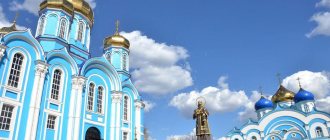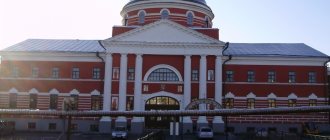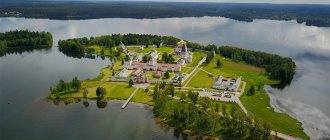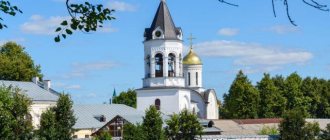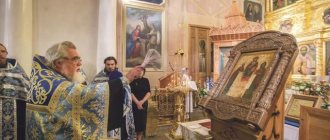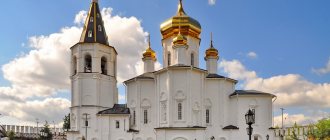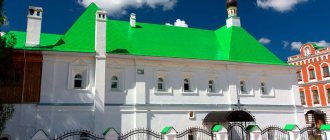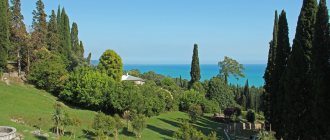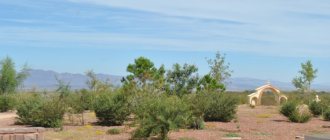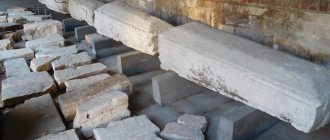Zadonsky Nativity of the Virgin Mary Monastery is the largest in the Lipetsk diocese and its spiritual center. This place is an object of cultural heritage of the peoples of the Russian Federation of regional significance. Thousands of pilgrims come here every year, and almost 400 inhabitants permanently live on the territory. We invite you to visit the sacred temple of God. The schedule of services of the Tikhon of Zadonsk Monastery, located in the Lipetsk region, in the city of Zadonsk, can be found on the official website.
Foundation and establishment of the Zadonsk Nativity of the Theotokos Monastery
The Zadonsky Mother of God Monastery was built at the beginning of the 17th century, according to various sources, from 1610 to 1620. With the now famous icon of the Vladimir Mother of God, the pious elder monks Gerasim and Kirill found themselves at the place where the Teshevka River flows into the Don. This is where the church was founded, which within a few decades became a full-fledged monastery. In 1779, the peasant settlement of Teshevka was renamed Zadonsk, and after this the monastery was renamed.
At the end of the 17th century, in 1962, there was a terrible fire that destroyed the church. Everything around burned to the ground, except for the very icon with which the elders came to the land of Zadonsk. Since then, they learned about the miraculous salvation and pilgrims flocked to the monastery. They donated money for the reconstruction of the monastery. Those who were unable to help financially worked hard with their hands.
In the thirties of the 19th century, the plague raged, but the icon again showed its power and protection over people - not a single person died from the terrible epidemic.
Life today
Those who came here unanimously write about the beautifully landscaped territory, the beauty of the magnificent churches, the wisdom of the confessors - there certainly weren’t 70 years of desolation. Here’s how, for example, Zadonsk resident Alexander is surprised by the changes:
“A place of attraction for pilgrims from all over the country. I am glad that the monastery is developing and becoming more beautiful every year. Here we baptized our son, not often, but we order services for health and peace. I also remember how several decades ago there was a vegetable drying plant on the territory of the monastery and we took onions home for cleaning. And the hospital huddled here in Soviet times, here I was born and subsequently had to be treated ... "
Abbots (vicars) and brethren
To date, the number of inhabitants has exceeded the pre-revolutionary 300: there are 380 monks and novices. Moreover, new tonsures are taken every year, so the number of monks continues to grow.
The social service of the brethren is as enormous as before the revolution. Monastery:
- helps build up to 10 temples;
- charitable supports 5 children's institutions, 5 hospitals;
- cares for prisoners in 20 (!) colonies;
- conducts educational activities - publishes a newspaper, holds the conference “St. Tikhon’s Readings”; There are also Sunday schools here - for children and adults.
Funds for these, as well as many other projects, are provided, as before, by an extensive economy. The brothers work in an apiary, a cannery, a fish farm, and in numerous workshops.
The brethren are now led by Abbot Trifon (Golubykh) . And the first governor upon the opening of the monastery was Archimandrite. Nathanael (Chernyak) .
Temples
Currently in effect:
- St. Vladimir's Cathedral;
- Church of the Ascension at the refectory;
- Church of St. John the Baptist at the bell tower; it has two chapels: St. Nicholas of Myra and Eusebius of Samosata;
- Winter Church of the Nativity of the Virgin Mary; it also has a chapel of the Tikhvin Icon of the Most Pure One;
- two churches of St. Tikhon of Zadonsk, one of which has a chapel of St. Ignatius the God-Bearer;
- Church of the Image of the Virgin Mary “Life-Giving Spring” , which, in fact, is located on the monastery spring; the temple was re-erected in 2003 on the site of the destroyed one; here the consecration of water for Baptism is performed;
- chapel at the Holy Gate.
Requirements
All of them can be ordered both in the churches of the monastery and on its website. It also provides brief, understandable explanations of the meaning and order of each sacred rite.
Relics of Tikhon of Zadonsk
Now, as before, this is the main shrine, for which people come here from all over the country. You can venerate them in the Vladimir Cathedral - where the atheists took them from. It is easy to recognize the location of the shrine by the magnificent canopy above it.
Zadonsky Monastery. Canopy over the relics of Tikhon of Zadonsk
Necropolis
It was devastated over the years of godlessness, many graves were lost. It is known that:
- under the altar of the cathedral church there is the grave of the founder of the stone structure here, archimandrite. Eusevia;
- in addition, abbots were buried in the cathedral. confessors of the brethren;
- the fraternal cemetery itself occupied up to a third of the territory, now the burial places are mostly lost; it is known that, in addition to monks and novices, representatives of many eminent noble families also found rest here - the Gagarins, Lermontovs, Bibikovs, and dozens of others.
Miraculous icons and other shrines
In the temples of the monastery you can venerate relics from Jerusalem, particles of the relics of many saints of God. There are also local shrines here, very dear to believers. Among them are two icons that the Orthodox managed to preserve from desecration during persecution. Apparently, they once belonged to the monastery, but since the 1990s they have been returned to their native walls. This is one of the lists of the miraculous image of the Mother of God of Vladimir, as well as an icon of St. Tikhon.
Nowadays the crosses and domes of the monastery rise above the city, as they did several centuries ago. People come here to pray to St. Tikhon, other devotees of piety. They come for help, advice from experienced confessors. And here, on earth, where monks have prayed for centuries, many meet God for the first time.
Natalia Sazonova
Development of the Zadonsk Monastery
1769 became the most important year in the history of the sanctuary: St. Tikhon moved to this place. He lived in the temple until 1783, and at the age of 59 he died. After his death, pilgrimages to his tomb began. When in 1846 they decided to rebuild the buildings, they discovered that the relics of the saint were not touched by decay, but only in 1860 did his glorification finally happen. Three hundred thousand Orthodox Christians came to the city for this event. This is forty times the population of Zadonsk itself. A large number of wonderful healings then occurred near the tomb. By the end of the 19th century, Nicholas I issued a decree according to which the Zadonsk Mother of God Monastery was raised from class 3 to class 1.
At the beginning of the 20th century, life here proceeded without shocks. But when the revolution happened, terrible events began: in 1919, the coffin with the relics of St. Tikhon was opened, and the ministers were expelled from the pilgrimage. Ten years later, some clergy were sent into exile, and the rest were driven out of these sacred places forever. Nothing survived from the former cathedral, and the saint’s relics were sent first to the local history museum, then to the Yeletsk land, and finally, before the war, they ended up in Orel.
Over the course of six decades, the building has changed enormously. Over the years, many secular institutions were located here: a vegetable drying factory, a sausage factory and an orphanage.
Holy Trinity Convent
The beginning of the fourth Zadonsk monastery was laid by a hospice house for the care of infirm wanderers who came to worship the shrines of Zadonsk. In 1860, at the community of sisters of mercy, a church was built in honor of the icon “Joy of All Who Sorrow.” The maiden community received the status of a monastery in 1888. The people called the monastery “Sorrowful” until the Church of the Life-Giving Trinity was erected, which became the throne for the monastery.
The Holy Trinity Convent existed until 1929. Of the buildings of the former convent, only the 5-domed Church of the Life-Giving Trinity (Trinity Cathedral) remains - an architectural monument of the 19th century. This is the only place in Zadonsk where newlyweds are married and children are baptized.
Church of the Life-Giving Trinity
Revival of the Zadonsk Monastery
The restoration of the main cathedral began in 88 of the 20th century. 1991 is an important year in the history of the sanctuary. Five people were tonsured as monks. In the last month of summer, the sacred relics of Tikhon again ended up in the Zadonsk Monastery.
In 1993, the remains of the revered righteous, which had previously been removed, were transported from the cemetery.
The cathedral was restored very quickly. The first to be built was the 80-meter bell tower. The domes of the main cathedral were gilded. The temple in honor of St. Tikhon was restored. Here they began to paint the faces of the saints that currently adorn the Vladimir Church.
In 1998, a major event took place. Alexei II paid a patriarchal visit. The worshipers received a blessed farewell.
Revival of the monastery in the 21st century
Only at the dawn of the 21st century was the process of returning all the buildings that belonged to the monastery before the revolution completed. In 2005, bells were raised to the bell tower. Now construction and reconstruction are almost completed. The area occupied by the monastery is 7.6 hectares.
In the 21st century, the good beginning of Tikhon of Zadonsk continues, and the church helps orphanages, medical institutions, prisons and low-income citizens. In addition, donations go towards the reconstruction of a dozen churches, as well as the construction of new ones.
In 2005, a monument to Tikhon of Zadonsky was erected in the complex.
In 2010, in honor of the four hundredth anniversary of its founding, a Divine Liturgy was held, led by Patriarch Kirill of Moscow and All Rus'.
Abbots, governors
- Prokhor (mentioned in 1632. It can be assumed that he was the first successor in the management of the pious elders Cyril and Gerasim of Zadonsk - the founders of the Zadonsk monastery).
- Leonid
- Ephraim I
- Ephraim II
- Tryphon (1693 - 1697)
- Ignatius
- Filaret
- Anthony
- Euthymius I
- In schematic Abel
- Euthymius II, in schema. Eusebius (1735-1745)
- In schematic Nikita
- In schematic Irinarch
- In schematic Pachomius
- In schematic Tikhon I
- In schematic Tikhon II
- In schematic Pitirim
- Stephen
- Tikhon III
- Barsanuphius I (- 1735)
- Barsanuphius II (1751 - ?)
- Cornelius, in the schema Cyril (mentioned 1763)
- Zosima
- Nifont, in schema Nikolai (1767 - 1774)
- Theodosius (1774 - 1776)
- Samuel I (1776 - 1777)
- Benedict (late 1777 - July 14, 1778)
- Samuel I (July 14, 1778 - 1787)
- Kliment (Beloshapkin) (late 1787 - 1789)
- Timofey (Sambikin) (1789 - 1805)
- Zosima, in the world Mikhail
- Barsanuphius (? - 1861)
- Hermogenes (Kritsyn) (2004 - 2005)
- Trifon (Blue) (2005 - 2011)
Monastery temples and other buildings
There are several temples on the territory of the sanctuary:
- The most important, central of them is the Cathedral of the Vladimir Icon of the Mother of God. The relics of eleven saints are kept here in a marble tomb. Also here are icons with particles of the relics of the righteous. These icons were painted by the residents of the monastery, to replace old ones that were damaged or lost during difficult times, and some were brought straight from Jerusalem;
- The Church of the Icon of the Mother of God “Life-Giving Spring” was built in 2003 to replace the one that was destroyed during the revolution. Three years later, a font for believers was built here;
- The gate chapel, together with the bell tower, is under state protection and included in the list of material and spiritual values of the Russian Federation;
- The bell tower with the Church of St. Nicholas the Wonderworker was reconstructed along with the Vladimir Cathedral. Thanks to photographs, they recreated the appearance of the structure so that it looked very similar to the destroyed one. The height of the building is 80 meters;
- Church of the Nativity of the Virgin. Reconstruction began only at the beginning of the 21st century. What survived from the destroyed temple served as the basis for the construction of a new one;
- The Church of Tikhon of Zadonsk and Ignatius the God-Bearer was built in 1870 at the burial place of St. Tikhon. It is a small church made of stone;
- Church of Tikhon of Zadonsk.
Current state[edit]
Currently, the monastery has been restored; The management of the monastic brethren, including more than 200 novices and 60 monastics, is carried out by the abbot, Abbot Tryphon (Golubykh).
Two of the most revered of the 20 holy springs that existed before the revolution were found and restored.
The monastery receives pilgrims and operates a number of free pilgrimage hotels.
On September 1, 2008, the Bank of Russia issued a silver commemorative coin dedicated to the Vladimir Cathedral of the Zadonsk Nativity of the Virgin Mary Monastery.
Cathedral of the Vladimir Icon of the Mother of God in Zadonsk
Shrines of the monastery
The most important shrine of God's temple is the relics of Tikhon of Zadonsk. When the dilapidated Vladimir Church was dismantled in 1846, it was discovered that the body of St. Tikhon was completely incorrupt. A letter about the discovery of the untouched relics was immediately sent to the Holy Synod, where it was not submitted for consideration for a long time, although Archbishop Anthony repeatedly reminded about the miracle. And only 14 years later, in 1860, an official examination of the relics of Tikhon of Zadonsk took place.
The 76-year stay in the tomb did not touch the saint’s body, and he acquired an appearance similar to the rest of the surviving incorruptible relics of God’s saints. August 13 (August 26, new style) was declared the day of remembrance of the new saint of the Russian Orthodox Church. Now believers are asking Tikhon to heal their souls and bodies.
On the territory of the Vladimir Cathedral, the central temple, the relics of 11 more righteous people are kept.
On this land, healing images with pieces of the relics of the saints are kept.
It is worth telling in detail about the wonderful icon of the Mother of God “Life-Giving Spring”. In 1692 there was a terrible fire that destroyed all the churches. Miraculously, only the icon of the Vladimir Mother of God was saved, which became widely known among all Orthodox believers. Later, during the cholera epidemic in 30-31. 19th century, the icon protected all the servants of the Lord in the church, so that not one of them died from a terrible illness. Days of veneration of the icon are 3.06, 6.07 and 8.09. In her honor, the Church of the Mother of God was built, next to which there are natural springs and a closed font.
History[edit]
Foundation[edit]
The Zadonsk Nativity of the Theotokos Monastery was founded by two elder schemamonks, Cyril and Gerasim, natives of the Moscow Sretensky Monastery, who brought around 1610 a copy of the Vladimir Icon of the Mother of God, which later became famous as a miraculous one[1]. The monks founded the first wooden church in the name of the Presentation of the Vladimir Icon of the Mother of God on the banks of the Teshevka River at its confluence with the Don.
Initially, the monastery received the name Zadonsky Teshevsky Theotokos, because relative to Moscow it was located beyond the Don River, stood on the Teshevka River and the main shrine was the icon of the Vladimir Mother of God. The further life of the founders of the monastery is not known for certain, but it is generally accepted that they continued to serve there until the end of their lives and were buried next to the temple, as evidenced by the entry in the funeral Synodikon.
Formation of the monastery[edit]
In 1692, a fire destroyed all the buildings of the monastery, including archives and property. Only the shrine remained unharmed - the icon of the Mother of God. Since then, the icon has become even more revered among believers.
By 1697, the monastery and all the previous buildings were restored. Construction was carried out with the diligence of Abbot Tryphon, who was the abbot of the monastery from 1693 to 1697. After 44 years, the former wooden church fell into disrepair and could no longer accommodate all the believers, so in 1736 Abbot Efimy II undertook the construction of the first church made of stone with two chapels - in honor of the Nativity of St. John the Baptist and in the name of Eusebius, Bishop of Samosad. Already in 1741 the main altar was consecrated. Under Abbot Efimiya, a stone fence with a gate and a Gothic bell tower were erected on the western side of the monastery. On the ground floor of the bell tower there was a temple in the name of St. Nicholas, and two-story cells with storage rooms were erected on the flanks. In 1769, Bishop Tikhon (Sokolovsky) of Voronezh and Yelets, who was already considered a saint during his lifetime, came to the monastery. With the arrival of St. Tikhon, the monastery gains its fame and veneration.
On September 10, 1798, Timofey (Sambikin), who had been its abbot for the previous eight years and was also a present member of the Voronezh Consistory, was elevated to the rank of archimandrite of the monastery. He remained in this position until July 15, 1805, when he was appointed abbot of the Solovetsky Monastery from Zadonsk. With the arrival of the new archimandrite, the construction of new buildings on the territory of the monastery is resumed - including the eastern one-story cell for the abbot and the two-story southern building for ministers; the construction of a stone fence with two towers (one has survived to the present day) is underway. At the same time, the Vladimir Church is being renovated - wall paintings are appearing, the roof is being re-roofed, and service courtyards are being completed. From 1779 to 1802, the District Treasury and government offices were located on the territory of the monastery.
At the end of the 18th century, the monastery was classified as a third class, according to which it was supposed to have abbots. In 1797, third-class monasteries were required to have archimandrites, so already in 1798 an archimandry appeared in the Zadonsky Monastery. The monastery was listed in 130th place in the 1810 list of all third-class monasteries.
With the increase in the number of pilgrims to the Zadonsk Monastery, an objective need arises for the construction of new buildings and renovation of existing ones. This is how the northern residential building for pilgrims was built, which was later used as cells. The building was later destroyed during the construction of a new building of the Vladimir Church. The Church of Our Lady of Vladimir itself was again painted and renovated in 1803. Under Archimandrite Innocent in 1806, a stone refectory was built with rich decoration in the form of columns, rich decorations and alabaster figures. It also housed the monastery bakery. Later the refectory was converted into a winter church. In 1815-16 cells, refectory and other buildings were renovated. In 1817, a two-story Ascension Church and a hospital building were added to the two-story building.
In 1818, a building for a theological school was erected next to the Ascension Church (the first two floors were occupied by students, the third floor was given to mentors). In the same year, George (Zadonsky) arrived at the monastery, who led a reclusive life in the monastery for 17 years.
Since 1814, the Zadonsk Monastery has taken into its care from 10 to 20 of the poorest students as pupils of St. Tikhon. In 1822, the board of the Voronezh province allocated 480 square meters to the Zadonsky Monastery for the construction of a bell tower and a hotel. m of land.
In 1827, Archimandrite Samuil submitted a petition to the diocese to expand the Vladimir Cathedral, to which His Grace Anthony XI replied: “Procurement of materials is permitted, but I recommend that the abbot take care not about expanding the existing church, but about building a new one, corresponding to the nobility of the monastery.” The construction commission approved the plan for the construction of a new temple, bell tower and hotel in 1829. The very next year the bell tower was rebuilt up to the second floor inclusive; it was erected separately from the church. In 1832, the main church was expanded and rebuilt, the painting and iconostasis were updated, and the roof was replaced.
On August 21, 1835, the bell tower was consecrated by Archbishop Anthony XI. Under the bell tower was the main gate, which was supposed to be used on special occasions. The entrance is decorated with a Greek portico supported by columns. In the entrance arch, the ceiling was painted with the image of two angels carrying the icon of St. Nicholas the Wonderworker, and the inscription “Hail to St. Nicholas the Great Wonderworker!” On the second floor of the bell tower, the Church of St. Nicholas of Myra was built, which was consecrated in 1838. On both sides of the bell tower there were buildings for pilgrims; the total number of rooms is 78. The bell tower had 11 bells. The very first and largest bell was cast (weighing 5 tons) in 1846, the second bell weighed 1965 kg, the third 1146 kg. The total mass of the bells was 9844 kg. Among the small ones was a bell discovered in 1815 in a vacant lot in the Donshchina.
In 1830, a fence with two entrances was erected between the hotel and the temple: from the bell tower to the Vladimir Church and from the hotel to the courtyard. Later, a sidewalk with pyramidal poplars on the sides was installed at the gate, leading to the Church of the Nativity of the Blessed Virgin Mary (rebuilt in 1834 from a one-story refectory brethren); later the relics of St. Tikhon were located here. The wooden room had arches in the side walls, and the vault was supported by 18 wooden columns with marbled plaster. The Church of the Nativity of the Blessed Virgin Mary had three boundaries: in the center - the Nativity of the Blessed Virgin Mary, on the right - in the name of Mitrofan, the first bishop of Voronezh and wonderworker, on the left - the Venerables Anthony and Theodosius of the Caves. In 1862, due to dilapidation, the temple began to be rebuilt into a stone one.
In 1838, the finishing work of the Church of St. Nicholas was completed and the church began to operate. In the same year, construction was completed (started in 1836) of a stone fence with two gates decorated with 8 columns.
In 1839, a decision was made to build a new main Cathedral to replace the dilapidated Vladimir Church, which existed at that time just to the north. At the same time, it was planned to remove all the dilapidated buildings of the monastery, replacing them with modern stone ones.
In 1841, the Vladimir Church fell into complete disrepair, as evidenced by the message of Archimandrite Markirius to the diocese: “from the monastery buildings in the refectory church of the Vladimir Mother of God, which is also the summer cathedral, there are cracks in the vaults, on the fraternal building where the school is, there is a leak; on barns and stables the roof is completely destroyed.” That same year, the temple was sealed and closed.
In 1845-1853, according to the design of the architect K. A. Ton (author of the Cathedral of Christ the Savior in Moscow), a new majestic five-domed cathedral was built in honor of the Vladimir Icon of the Mother of God. The iconostases for it were provided by the artist T.E. Myagkov. The new three-story temple had three entrances, a central dome and four towers covered with white iron with images of crosses and apples made of red gold. On the sides of the entrances the temple was decorated with ten columns with pilasters. Altars and worship spaces are raised 1 meter above the floor. The temple had 8 thrones: in honor of the Vladimir Mother of God, the Protection of the Mother of God, in the name of Alexy, Metropolitan, and Simeon the Stylite, the holy martyr Queen Alexandra, the holy first martyr Archdeacon Stephen, in the name of the Most Holy Trinity, the holy righteous Anna, the holy Great Martyr Catherine. The outside of the temple was plastered and covered in blue, while the altar, meals and gables under the roof were painted green.
One of the main shrines of the temple is the miraculous Vladimir icon, which was placed near the choir. The icon's robe is made of silver with gilding and decorated with pearls and precious stones. The icon survived the fire of 1692 and helped during the cholera epidemic in Zadonsk in 1830-31. and 1848 (the disease was rampant in the monastery, but no one died from it), saved Zadonsk in June 1861 and August 1, 1869 from destruction by fire (the icon was brought to the fire with a prayer service and the fire subsided, which made it possible to put it out). Also especially revered are the following icons of the Cathedral: the Savior and the Mother of God, the Holy Blessed Prince Alexander Nevsky, the Savior, the Mother of God, the sacrifice of Abraham and the vision of the prophet Isaiah, the holy martyr Valentina, Mary of Egypt.
Monument to Saint Tikhon of Zadonsk
The temple was solemnly founded on June 10, 1845 with the blessing of Archbishop Anthony II and rector Archimandrite Hilarius. The slab laid at the base reads: “In the name of the Father and the Son and the Holy Spirit. This church was founded in honor and memory of the Vladimir Mother of God, under the power of the Most Pious Autocratic Great Sovereign of our Emperor Nikolai Pavlovich, under the sanctity of Mr. His Eminence Anthony, Bishop of Voronezh and Zadonsk, and the holy Archimandrite Ilarius, 1845 June 10th day; whereby the relics of the Saints of Our Father Mitrofan I, Bishop of Voronezh and miracle worker, are enshrined.” The lower floor was consecrated in 1848, the rest on August 13, 1853. The temple was covered with English tin in 1858.
Finding the relics of St. Tikhon of Zadonsk[edit]
In 1846, during the dismantling of the old wooden Vladimir Church, it was discovered that the crypt in which St. Tikhon rested was partially destroyed, and his coffin, damaged by fallen bricks, was severely dilapidated. Then it was noticed that the deceased archpastor, having spent 63 years in a damp place, was not touched by decay. The body was transferred to another tomb, which was placed in a warm temple. Archbishop Anthony of Voronezh reported this fact, as well as the miracles of healing at the tomb, to the Holy Synod, and also wrote a letter about this to Emperor Nicholas I on the day of his death.
Subsequently, to establish the fact of the discovery of the relics, a commission was created, which included Metropolitan Isidore of Kiev, the local Right Reverend Archbishop Joseph and the Moscow Archimandrite of the Intercession Monastery Paisius, two people from the Zadonsk clergy and two hieromonks of the Zadonsk Monastery. On May 19, they witnessed the fact of the incorruptibility of the relics and vestments of St. Tikhon. After this, the Holy Synod sent a petition to Emperor Alexander II to canonize Tikhon of Zadonsk and make August 13 a memorable day. Alexander Nikolaevich signed the petition as follows: “I agree with the opinion of the Holy Synod. Alexander".
By the beginning of the 20th century, the Zadonsk Monastery was a whole town, consisting of 6 churches, a bell tower, a hospice house, a hospital, a pharmacy, two brick factories, one candle factory, and a parochial school. The brethren of the monastery numbered about 300 people.
Soviet period[edit]
In the 70-80s of the 20th century, a canning factory was located on the territory of the monastery, in all its buildings, and the cathedral itself was converted into a warehouse for products.
Recovery[edit]
In 1990, the Vladimir Cathedral and part of the monastery buildings were returned to the Russian Orthodox Church. The first bishop's service in the cathedral took place on August 26, 1990, on the day of memory of St. Tikhon of Voronezh, the Wonderworker of Zadonsk.
Schedule of services at the Zadonsky Monastery
A detailed schedule of services in the monastery of Tikhon of Zadonsk, located in the city of Zadonsk, Lipetsk region, can be found on the official website or in person at the chapel.
The language of worship is Church Slavonic. Services are held daily in the following order:
- During the morning hours at 6:00, 6:40, 7:30 and 10:00;
- Exactly at noon;
- In the evening at 17:00.
At 3 a.m. on major holidays and weekends, an early liturgy is held.
Particularly important dates in the monastery (according to the new Gregorian calendar) 3.06, 6.07 are the feasts of the icon of the Vladimir Mother of God, 26.08 is the day of memory of Tikhon of Zadonsk, 21.09 is the Nativity of the Blessed Virgin Mary.
There is a church shop at the monastery where visitors can buy blessed goods for themselves and their loved ones.
Entering the territory in decent form - females must wear a skirt no lower than the knee and with their heads covered, males must have their legs covered.
Where to stay
The three-story Zadonsk hotel opposite the monastery is the simplest solution to the issue of spending the night in Zadonsk. It offers rooms of the “Lux”, “Comfort”, “Economy” types, costing from 750 to 5000 rubles. per person. Hotel address – st. Communes, 13.
Pilgrims of the Nativity of the Virgin Mary Monastery can stay at the hotel on Lenina, 28 - two hundred meters from the monastery. The cost of an overnight stay is 600-1000 rubles. per person.
Other accommodation options in Zadonsk can be found here.
In the monastery itself, a social hotel has been operating for almost 30 years: you can stay within the monastery walls completely free of charge, but for a short period of time. Accommodation inside the monastery provides for mandatory participation in divine services and performing feasible obediences.
Advice: if you want to attend a night monastery service, take the opportunity to spend the night in the social hotel of the Bogoroditskaya monastery. All other accommodation options will not allow you to enter the monastery territory at night.
Address, contacts of the Zadonsk Monastery
The monastery in Zadonsk has an official website on the Internet, zadonsk-monastyr.ru. On the cathedral's page there is a modern service for ordering requirements online. You need to select your request for health or peace, put it in your usual cart, like in an online store, and pay online.
The web page also contains a postal address to which you can write a letter with a request for the desired service addressed to nun Nina. An email address is also indicated there. Progress has also reached holy places, which is very convenient for people with limited mobility, for example, wheelchair users, mothers with small children, and non-residents.
If you want to come to the house of God in person, the address of the Nativity of the Theotokos Zadonsk Monastery, Lipetsk region, city of Zadonsk, Komunny street, building 14; coordinates for your navigator 52.392049, 38.918063.
If you prefer personal transport, you can get there from Moscow along the M-4 Don highway, following the signs to the south, to the city of Zadonsk. The sanctuary itself is very visible from the highway, so it is impossible to get lost.
By train, choose routes to Lipetsk, and from there there are direct buses to Zadonskaya bus station.
If you choose buses, the easiest way to get to the pilgrimage from the capital is on the Moscow-Voronezh bus, since it has a stop in the city of Zadonsk, which is very convenient.
From Zlatoglavaya to Zadonsk 410 km, from the pearl of the Black Earth Region 73 km along the highway, from Voronezh 94 km.
On the website of the Zadonsk Monastery there is a “contacts” section for information for pilgrims: 8-904-285-95-80, 8-919-169-66-87, 8-961-602-01-02.
And on the Vesti-Lipetsk website you can watch a video about the life of the monastery:
How to get there by car, public transport
Zadonsk can only be reached by road.
By bus
The distance between Zadonsk and Moscow is 425 km. From the bus station at the Krasnogvardeyskaya metro station at intervals of 15 - 60 minutes. Buses NN 555, 1333, 979, 1396, 1335 depart, heading to Zadonsk or through Zadonsk to other cities. Travel time is up to 7 hours. Ticket price – from 935 rubles.
If you take a train to Voronezh from Kursky or Kazansky train stations (travel time 6-10 hours, cost from 678 rubles), then you will have to use an intercity bus. From the Central Bus Station of Voronezh, located on Moskovsky Prospekt, 17, a bus leaves for Zadonsk every hour. Distance – 85 km, travel time – about 2 hours, ticket price – from 250 rubles.
By car
By car from Moscow you need to travel along the M4 (Don) highway. It is impossible to drive through Zadonsk; the city is clearly visible from the highway.
By turning at the sign and crossing the Don Bridge, travelers will find themselves at the Zadonsky Monastery. They will cover the 425 km journey in 6 hours.
Private hotel for pilgrims
The mini-hotel is located at the address: Zadonsk, st. Lenina, 28. Built in 2013. The guest house does not have stars, but all the rooms are cozy, cleaned every day, and it is convenient for the whole family to stay here. Check-in time is at 8 am and check-out time is at 21 pm. Meals include only a la carte breakfast, but the rooms have a kitchenette for self-catering.
The hotel has only 11 rooms. The hotel is managed by Mother Magdalene, she will advise all guests on accommodation in the city and on the schedule of services at the Zadonsky Monastery. Prices start from 2 thousand rubles per night in a four-bed room. There is internet throughout the hotel. For guest comfort, the rooms are equipped with air conditioning. Convenient parking: you can park your car in the yard.
Zadonsk Map
When planning to visit Zadonsk, take the time to study the city map with streets and house numbers. She will tell you a lot of interesting things about the history of the city and help create an interesting walking route.
Since the time of Catherine II, Zadonsk has been built strictly according to plan, with the streets oriented to the cardinal points. The bed of the Teshevka River divides the city into 2 parts: Northern – Dvoryanskaya and Southern – Meshchanskaya. The longest streets of the city stretch parallel to the Don from south to north: Karla Marx (formerly Dvoryanskaya Street) and st. Krupskaya (formerly Sobornaya).
The main temples of the city occupy dominant heights, reflecting the development of the city from south to north.
The Assumption Cathedral (15 Uritsky St.) is the center of the Meshchanskaya Sloboda; Zadonsk fairs were held on Market Square in front of the cathedral.
The famous “golden Lenin” stands here, pointing with an energetic gesture at the magnificent ensemble of the Bogoroditsky Monastery (Kommuny St., 14).
Following from the monastery along K. Marx Street, we see the flaming Trinity Cathedral (K. Marx Street, 85) and further on the horizon rises its twin - the Ascension Cathedral in Tyunino (beginning of K. Marx Street).
Tip: find an object on the Zadonsk route with the address: st. M. Gorky, 34. Here is an amazing landmark of the city - the Singing Oak, which streams myrrh, sings akathists and heals people. Anyone who takes the time to find this place and reach it can touch the Mystery.
Desolation of the monastery
In the times following the October Revolution of 1917, Soviet atheism set in, and the clergy were expelled from the monastery. Tikhon's relics were desecrated, all property was taken away, and the monastery began to be disbanded. It should be noted that the bell tower was dismantled during the Second World War so that it would not be noticed by enemy troops.
During Soviet times, there was a children's correctional colony, a state farm, a hospital, a school, and even a neuropsychiatric dispensary here. But even then, nurses maintained the source of the monastery, now the Holy Transfiguration convent in the city of Zadonsk, and brought patients to it. The police often set up a cordon, and opponents of the church caused trouble, for example, filling the spring with cement or pouring in bleach. The boarding school was here until the collapse of the USSR; the buildings were completely destroyed.
Saint Tikhon in Voronezh
The position of Bishop of Voronezh became a test for Bishop Tikhon. The Voronezh diocese was huge in its territory and very heterogeneous in its population. Wealthy citizens adhered to the freethinking ideas of the French encyclopedists and atheism. The lower strata of the population gravitated toward schism and paganism. And most of the priests were extremely uneducated. And the diocese itself was one of the poorest in the Russian Empire. The bishop's house had long since collapsed, the cathedral had fallen into disrepair, all the bells were broken.
Therefore, Tikhon began his leadership of the Voronezh diocese with the restoration of the theological seminary and schools. He rightly believed that the moral state of the flock is directly related to the education of the shepherds. By the way, the seminary revived by Tikhon became the cultural and educational center of Voronezh. People were accepted there regardless of class, so its graduates eventually became not only priests, but also teachers and officials. At the same time, the bishop personally supervised the educational process, often attending classes and directing training in the right direction. Vladyka tried to help students from poor families whenever possible - he remembered all too well his student years spent in complete poverty.
Under Bishop Tikhon, regular catechetical teachings for the people began to be held in the Annunciation Cathedral. It was necessary to eradicate a huge number of pagan beliefs, which were traditionally adhered to in the Voronezh diocese. For example, festivities glorifying Yarila were very popular there. The fair tent was pitched, one could watch the frantic dancing of jesters, followed by a drunken crowd raging and rampaging. So, Tikhon Zadonsky came to such a holiday in 1765. His speech was so fiery that the crowd instantly sobered up, demolished the booth and immediately repented.
But energetic people often irritate others. This is what happened with the bishop. Over time, the local clergy began to oppose his reforms. In addition, Tikhon’s health deteriorated greatly, and he asked for resignation. First, the bishop retired to the Spaso-Preobrazhensky Tolshevsky Monastery near Voronezh. But the abbot of the monastery was dissatisfied with Tikhon’s presence. And the damp climate in that area did not benefit the ruler. And he was forced to move to the Bogoroditsky Monastery on the high bank of the Don.
Construction of the monastery
Archimandrite Seraphim began to build a monastery - an oak frame was installed on the source of holy water, several huts were erected for the worshipers of the Lord, and an apiary was founded. In this guise this place existed until 1864.
A year later, a stone and wooden church was erected on this site, which became increasingly popular among the monks. The issue of building the future St. Tikhon's Transfiguration Convent in Zadonsk remained pressing; it required effort and time. Archimandrite Dmitry led the construction of the facility. In 1873, the Tikhonovsky non-staff monastery for men was opened. Not only a two-story cathedral and a church were erected, but also a bell tower, buildings for the brethren, and the apiary was expanded. The owner of the nearby lands, a landowner, donated the forest, and the monastery was able to exist at the expense of its own industry. A little later, a stable, a chapel, and a hotel for parishioners were built. A hospital even started operating here. At the beginning of the twentieth century, it numbered about one hundred clergy.
